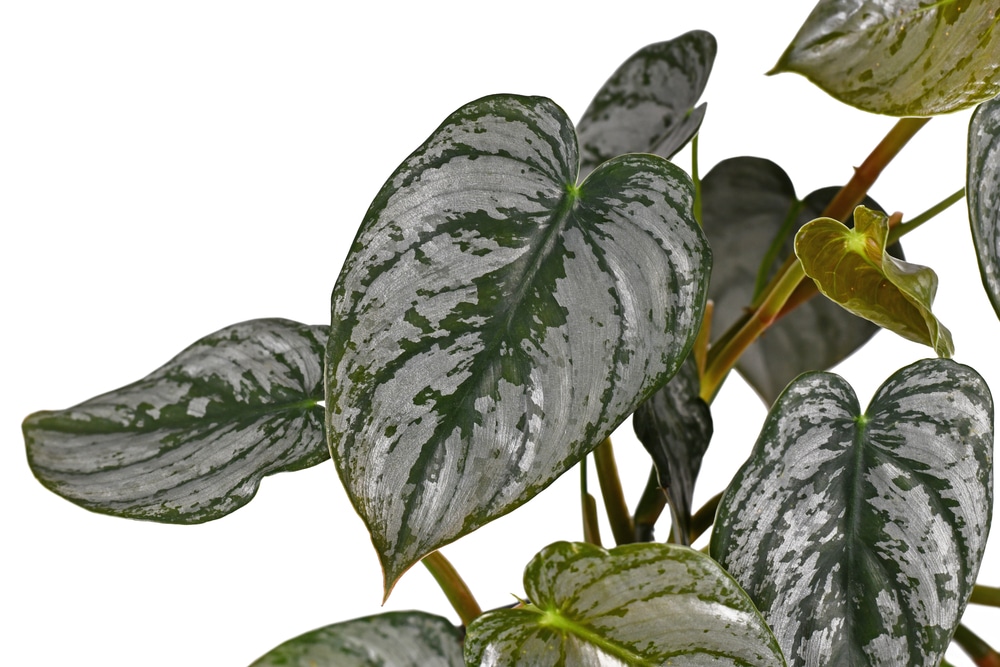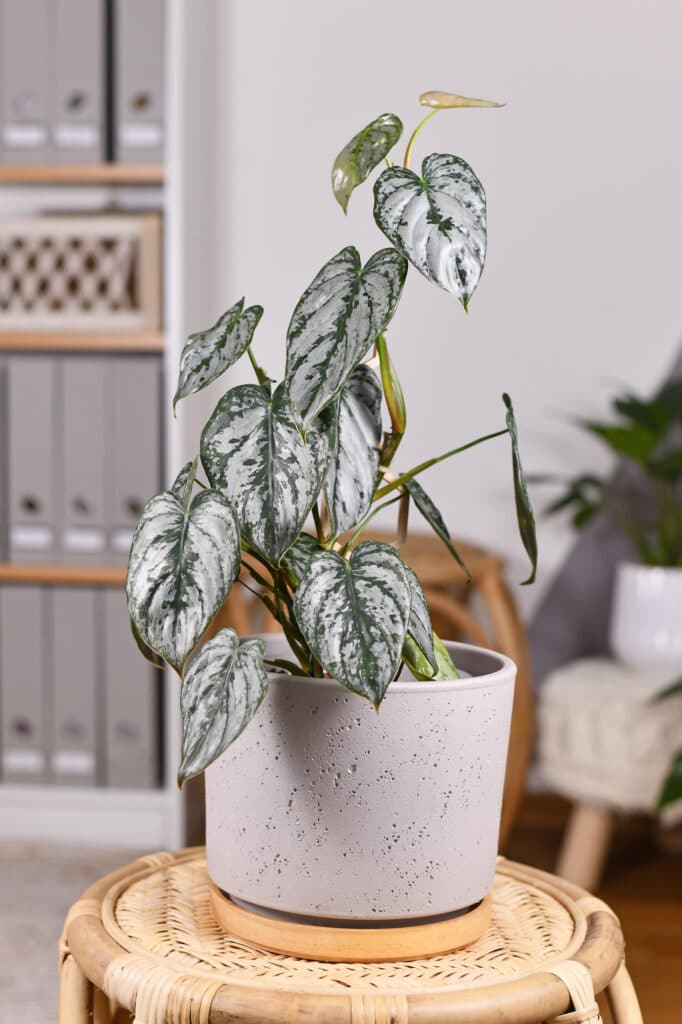There is a common saying amongst botanists: “Philodendrons are the easiest to grow and the hardest to kill”. This sentiment certainly rings true for the Philodendron Brandtianum, whose ease of maintenance coupled with her striking, shimmering, silvery foliage is sure to make her a beautiful and unique addition to any houseplant connoisseur’s collection.
Origin and History
Philodendron Brandtianum, better known as Silver Leaf Philodendron or Philodendron Brandi, is one of over 400 species in the Philodendron genus of the Araceae family. Like the majority of her philodendron kin, Brandi hails from the tropical rainforest regions of Bolivia, Brazil, Columbia, and Ecuador. Philodendron Brandtianums are unique in that they can grow as terrestrial (along the ground), epiphytical (from other plants), and hemiepiphyte (a mix of ground seed and epiphytic) plants.
The genus name Philodendron is derived from the Greek philo meaning ‘love’ or ‘affection’, and dendron, meaning ‘tree’. Translated loosely, it means ‘tree hugger’, a fitting testimony to the way this genus embraces trees and other plants for support as they grow upwards.
Appearance
Philodendron Brandi is instantly recognizable for her plentiful olive-green foliage, with each heart-shaped leaf adorned with large wedge-shaped silvery-white markings, giving a muted shimmering effect. The average size of mature leaves is around four to seven inches, although they can reach 12 inches in length. Brandi typically has much thicker foliage than her other philodendron counterparts.

Philodendron Brandtianum Care
In this section we cover important Philodendron brandtianum care topics such as watering, lighting. fertilizing, and more.
Growth Habit
Philodendron Brandi is a climbing and vining evergreen plant. Her versatile growth habit as both ground and epiphytic dwelling mean she is equally as happy trailing from a hanging basket as she is trained upwards around a moss pole. Philodendrons are fast-growing houseplants, and with the right conditions, your Brandi could reach up to four or five feet tall, albeit with a relatively narrow spread.
Brandi has a relatively compact growth habit, with densely packed foliage. New leaf growth will often emerge much more vivid, almost orange in color, as opposed to older leaves which adopt a more muted olive tone over time. Brandi is evergreen, meaning she shouldn’t shed leaves in the winter, although it’s perfectly normal for older leaves to drop periodically all throughout the year. Brandi will stop growing during their winter dormancy period.
Light
Hailing as she does from the depths of the South American rainforest floors, your Brandi will appreciate light conditions that mimic the dappled sunlight of its natural habitat. In the home, she likes plenty of bright, indirect light for six to eight hours per day. Too much direct sun will cause her deep green foliage to fade. Placing her in a north or east-facing window is ideal, but you could also place her in a south-facing window with a translucent voile to diffuse to bright sun.
Brandi’s are fairly tolerant of low lighting, although they grow much faster and develop larger leaves when they receive more light. Dark conditions can cause your Brandi to stretch out in search of the light, causing her dense foliage to become sparse and leggy, and stunting the development of new leaves.
Watering
Philodendron Brandi needs a fair amount of water to flourish.Throughout the growing season, you should aim to keep her soil evenly moist but not saturated. The key is to water little and often. During the summer, she will get thirsty and will need light yet consistent watering about three times a week. Check that the top two inches of soil have dried out between waterings as Brandi will not tolerate sitting in very wet soil for long periods, and always allow the soil to drain after each watering. Overwatering will cause her to drop foliage and makes her susceptible to root rot, particularly during the winter when her thirst is considerably reduced, when you can reduce watering to once a week or even less.
Philodendrons are a resilient bunch and can survive short periods of neglect without being too dramatic. If you do forget to water your Brandi for a week, don’t fret, the damage will be minimal so long as you don’t allow her to become parched for prolonged periods. Drought will cause her foliage to shrivel or curl up.
Temperature and Humidity
Brandi needs a warm and humid environment to thrive in the home. The optimal humidity level for Brandi is 60% and above, but anything above 50% will suffice. If your home lacks humidity you can mist her occasionally, but make sure the room is well ventilated, as lingering moisture on the foliage can cause fungal and bacterial infections. Keeping Brandi in amongst other, similar tropical plants will help to maintain consistent humidity.
The optimum temperature for Brandi is anywhere between 65-95 °F. She will begin to struggle if the temperature drops below 60°F for any length of time. She should be kept well away from any extreme temperatures or very dry areas, such as draughty windows, radiators, or air conditioning units. Consistency is key with Brandi, as any sudden temperature changes can cause her to go into shock. Maintaining stable humidity and temperatures will promote healthy growth and bigger leaves.
Soil and Pots
Brandi’s aversion to soggy soil means that a well-draining potting mix is essential! Avoid adding too much dense material to your potting mix as this will hold on to water, but a small amount of sphagnum moss or coco coir will help to maintain uniform moisture levels throughout. Adding organic material like peat moss will improve the fertility of her soil, whilst a good portion of vermiculite or perlite will aid drainage. Ideally, her soil should have a neutral to acidic pH level of between 6.1 and 7.3
Proper drainage is crucial. Despite being a thirsty plant, Brandi hates sitting in stagnant water or overly saturated soil so choose a pot with plenty of drainage holes that allow excess water to drain freely. Brandi prefers her roots to be a little loose, so they are quite comfortable in a slightly oversized pot. If you want to encourage Brandi’s climbing nature, place a moss pole into the pot and she can be easily trained to grow upwards.
Fertilizing
During the growing season, monthly feeds with a general-purpose fertilizer diluted to half strength will help to speed up the growth rate and encourage foliage density. During winter, Brandi will stop actively growing, so there is little need to feed her.
Pruning
Philodendron Brandi requires minimal pruning. She naturally drops older leaves throughout the year, but you can help speed up the process by periodically removing any discolored, damaged, or drooping leaves. Pruning lightly like this a couple of times a year is enough.
Repotting
If you notice your Brandi’s roots are become suffocated or compacted in the pot, it’s time to transfer her to something bigger. She will let you know when she needs repotting as her growth will slow considerably, but two to three years between repotting is generally the norm. Remember that Brandi likes loose roots, so make sure you choose a new pot with plenty of space for her roots to spread. The looser her roots, the healthier and faster her growth will be.

Philodendron Brandtianum Propagation
There are two easy ways to propagate your Philodendron Brandi. The first is water propagation from cuttings, and the second is by air-layering. Both methods are best done in spring or summer when your plant is actively growing.
Water Propagating
- Select a few inches of healthy stem with two to three leaves and cut just below the leaf node.
- Place the node end of the stem cutting in a clear container of water, making sure the leaves aren’t submerged.
- Place the container in a warm spot with bright, indirect light.
- Refresh the water weekly, and in around 3 weeks you should begin to see new roots emerging from the node.
- Once the roots have established themselves, transplant your cutting to a pot filled with a substrate similar to that of the parent plant, and place it somewhere with bright, indirect light.
Air Layering
Air layering is a method of propagating new plants whilst they are still attached to the mother plant.
- Choose a healthy stem with several existing leaves and at least one leaf node (two or more nodes is best).
- Make a small incision on the stem around an inch below the node.
- Wrap the incision with dampened sphagnum moss, and cover the stem and moss with a clear plastic bag, securing with tape or string to trap the moisture. Don’t secure the bag too tightly as this will prevent new roots from growing.
- New roots should emerge from the wound in three to five weeks. At this point, you can remove the bag and snip the new plant below the roots. Be careful not to cut the fledgling roots.
- Transplant your baby Brandi to a pot filled with a substrate similar to that of the parent plant, and place somewhere with bright, indirect light.
Both methods are relatively simple and effective, so whichever method you choose, you should be welcoming healthy new baby Brandi’s to your collection very soon.
Common Issues with Philodendron Brandtianum
In this section we cover a few of the most common pests, issues, and diseases to look out for when keeping Philodendron Brandtianum.
Disease
Overwatered Brandi’s are prone to diseases such as root rot and Leaf Spot disease. Symptoms of Leaf Spot disease are wilting foliage and reddish-brown splotches appearing on the leaves. There is no cure for Leaf Spot disease although with the right care your plant should recover. Remove any affected leaves and allow the soil to dry out somewhat, removing any lingering water from the foliage. Applying neem oil to the foliage will help to eradicate any loitering bacteria.
Root rot symptoms to look out for are drooping, browning, or yellowing foliage, and rotting stems. Sadly, a Brandi with root rot is usually unsalvageable. The best way to avoid root rot is to carefully monitor the water intake of your Brandi, sticking to a regular but light watering schedule during summer and reducing this in the winter.
Pests
Philodendron Brandi is susceptible to the usual houseplant pests.Spider mites, mealybugs, scale bugs, and aphids are all likely culprits, and an infestation will seriously stunt the growth of your plant, as well as cause unsightly damage to the leaves. Most pest infestations are identified by clusters of white, brown, or yellow patches, or fluffy clusters on the foliage. Spider mites may also weave webs around the foliage.
The most effective way to treat an infestation is by giving your Brandi a gentle but thorough clean with neem oil, insecticidal soap, or rubbing alcohol, using a soft cloth or cotton swab. You may need to repeat this a couple of times to clear the infestation completely. Any heavily infested leaves will need to be removed. Treating your plant with neem oil a couple of times a year can prevent future infestations from taking hold.
Common Questions
Here are a few of the most common questions that we get about Philodendron Brandtianum care:
Is Philodendron Brandtianum Toxic?
Yes! Philodendron Brandtianum is toxic to both animals and humans as it contains high concentrations of calcium oxalate crystals. If ingested, it will irritate the stomach, cause burning of the mouth, vomiting, and difficulty swallowing, so it’s best to keep this one safely out of reach of inquisitive little hands and paws.
Is Philodendron Brandtianum Rare?
On the whole, philodendrons are a fairly common houseplant, and they have gained serious popularity over recent years. Brandi, however, is definitely one of the rarer varieties and is highly prized for her unique shimmering silver foliage.
Is Philodendron Brandtianum Purify An Air Purifier?
Philodendrons are renowned for their purification qualities, removing toxins and chemicals like formaldehyde from the surrounding environment, and the Brandi is no exception!
Troubleshooting
Here are some common troubleshooting questions about keeping Philodendron Brandtianum:
Why are my Philodendron Brandtianum Leaves Curling?
Curling leaf tips are often caused by over-fertilizing. If you notice Brandi’s leaves beginning to curl, thoroughly soak the soil to rinse away the excess feed, allowing it to drain fully afterward.Curling and drooping leaves can also be a symptom of underwatering, so check the moisture levels in the soil.
Why are my Philodendron Brandtianum Leaves Browning?
Frustratingly, browning leaves can occur both as a result of over and under watering your Brandi. Checking the moisture levels in the soil should help you to determine the cause and act accordingly. Browning leaves can also occur when humidity levels are too low. Misting your Brandi or moving it to a more humid spot in the house should solve this.
Why are my Philodendron Brandtianum Leaves Fading?
Yellowing or fading foliage is a sign that your Brandi is receiving too much direct sunlight and should be moved to a more sheltered position.

